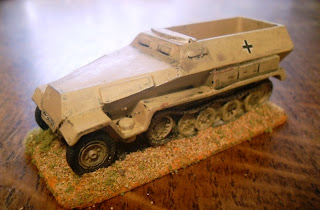Firstly, a Minimi resin version finished for my Panzer Armee Afrika. Reasonably clear lines, no forward mg or mg shield, no anti-aircraft mg or pintel.
Second, a Matchbox Hanomag which I made in 1982. Little in the way of internal detail, but with both mgs, although the AA one has long gone.
Finally, a Frontline Miniatures resin one - rough and ready, but very good value for money, with little internal detail and no mgs.
And, all three. Size wise, they are pretty close. But none came with crew (or did the Matchbox one have a gunner?), or stowage, or extra bits of any kind.
As for the PSC Hanomags, the delay is in the painting of the crew. Dan M has commented on this blog about the PSC kits, pointing out a problem with the platoon commanders PAK38, and directing me to a very good blog from Sweden, to be found here (well worth adding to one's favourites. The header Jagdpanzer IV is fantastic). The Swedish bloggist, Leif, provides a very good review of the PSC Hanomags, but I notice that he says that the crew must be Waffen SS as they are wearing smocks. That doesn't sound right to me, as I thought the pull over smock came in a variety of camouflage and non-camouflage patterns and was worn by all sorts and manners of German. I may be wrong, but I'm going for early marsh pattern smocks on my little fellows, as opposed to pea dot.


















































